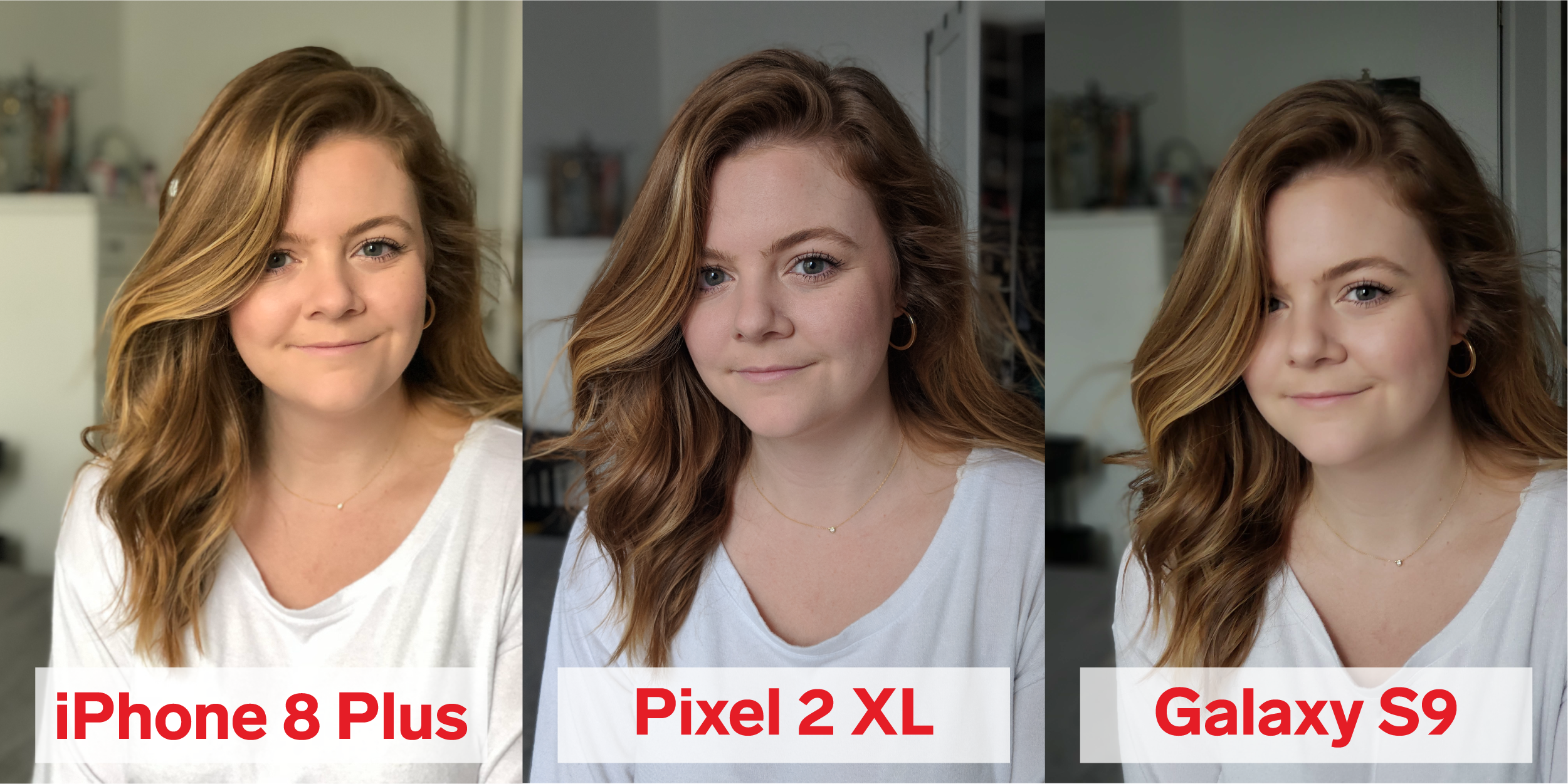When Apple introduced portrait mode on the iPhone 7 Plus nearly two years ago, it became a much talked-about and sought-after feature.
A phone that could give your photos that coveted look of a fancy, expensive camera? It sounded like a dream come true.
Since then, other premium smartphone makers have added the feature to their own devices. Samsung’s version is called Live Focus, and Google added its own version of the technology to both sizes of the Pixel and the Pixel 2.
I’m not a professional – or even amateur – photographer, but I do enjoy trying to capture beautiful photos on my smartphone. I wanted to put the feature to the test on three of the top smartphones right now: the iPhone 8 Plus, the Pixel 2 XL, and the Galaxy S9.
Over the course of a few days, I tested the feature in all sorts of conditions and situations, like low light, indoor and outdoor light, and busy backgrounds. While all three phones had their own strengths and weaknesses, one phone was the most consistent.
Here's how it went:
A simple indoor shot presented unique challenges for all three phones.
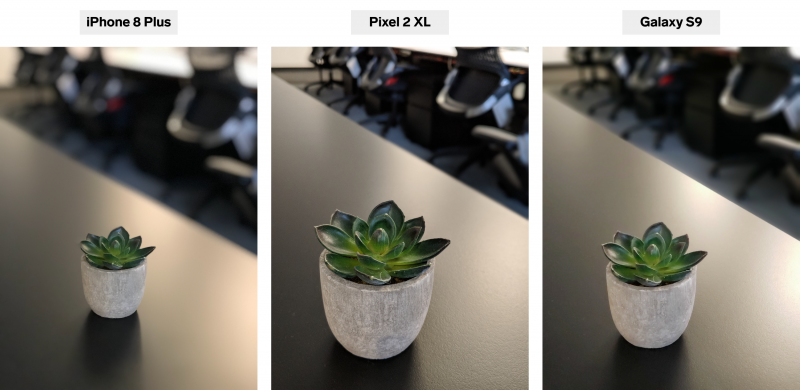
What began as a seemingly simple trial - a small plant photographed on a black table - ended up being a bit more complex.
- The iPhone 8 Plus, on the left, looks pretty good, although it's not as sharp as I would have liked, and the leaves in the back are a bit blurred.
- With the Pixel 2 XL, the plant is nice and sharp, but the background blur is strange and uneven. The Pixel 2 uses technology rather than lenses to create the blur, and in this case, it shows. The desk chairs aren't blurred enough, and it's distracting.
- The photo taken by Galaxy S9 is ... fine. It's not as sharp as the Pixel 2, but has a more even and less detailed background blur.
When taking this photo on both the iPhone 8 Plus and the Galaxy S9, I had to back away several feet to capture the same shot. This remained a theme throughout my tests because of the dual lenses - the Pixel 2 only has one lens, and could easily capture a shot at the distance I preferred. But every time I wanted to switch to either of the other phones, I had to move back several feet.
Winner: Pixel 2
When it came to shooting a portrait outside, there was a clear winner.

I took these three photos - one right after the other and standing in the same spot - and they all turned out completely different.
- The iPhone 8 Plus photo turned out OK, although it resulted in a much closer crop than either of the other two. Plus, the warmer nature of the iPhone's camera made his skin tone look much more orange than it actually is in real life.
- The Pixel 2 photo is the best of the bunch. The color is most true-to-life, it's the sharpest, and the background blur looks the best. This was taken on a rainy morning in New York, so it wasn't that bright out, but the other two phones completely blew out the background.
- The Galaxy S9 didn't take a great photo. The background is so blown out that it even affected the subject of the photo, eliminating a chunk of his arm. Plus, it added a yellowish tint to his skin that isn't there in real life.
Winner: Pixel 2
This outdoor shot resulted in a close call between the iPhone 8 Plus and the Pixel 2.
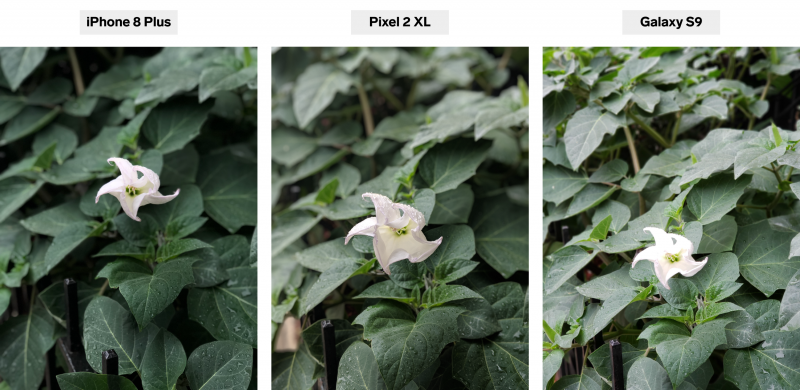
In this case, there's not a clear winner - it all comes down to personal preference.
- The iPhone 8 Plus captured a beautiful photo. The colors are rich, the details are sharp, and the blur is subtle and natural.
- The Pixel 2 also performed well here. The colors aren't as rich or vibrant as the iPhone 8 Plus, but the phone still captured a beautiful photo - you can even make out the raindrops on the flower. Plus, it was easier to capture since I didn't have to back away from the subject to get portrait mode to work.
- The Galaxy S9 once again didn't fare well. In general, the photo is OK, but the flower is too blown out and you can barely make out any detail. You might be wondering at this point if it's operator error, but I promise it's not - with each test of the Galaxy S9, I usually had to take twice as many photos in an attempt to get a good one, and rarely succeeded.
Winner: iPhone 8 Plus
When it came to a low-light test, two out of three phones had issues.
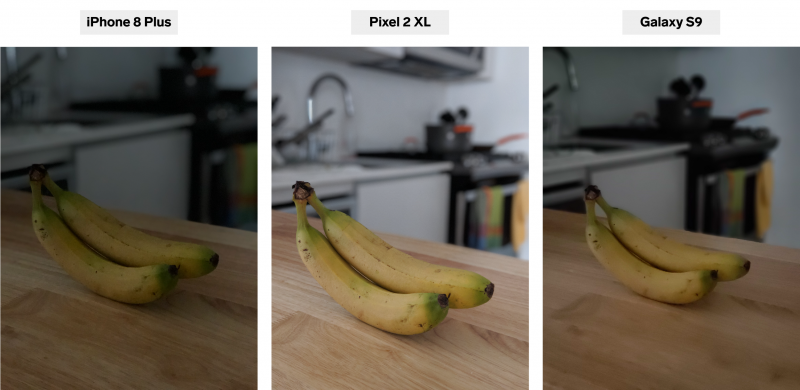
The low-light test was perhaps the most challenging of all.
On both the iPhone 8 Plus and the Galaxy S9, the phones themselves will let you know that they require lots of light to create an effective portrait mode photo. That being said, I wanted to test the phones in every condition - it's unrealistic to expect that everyone has perfect natural light every time they want to take a portrait mode shot.
- The iPhone 8 Plus had some challenges. The phone really struggled in low light, and kept trying to use the flash, which resulted in an ugly, unflattering shot (my bananas looked like hostages). After fiddling with the camera for several minutes, I finally captured a decent yet dark image.
- The Pixel 2, on the other hand, performed flawlessly. I didn't really need to worry about the lack of light since the portrait mode effects were added after the fact. I didn't brighten that photo at all - that's exactly how it looked once it finished processing.
- The Galaxy S9 was deeply disappointing. The end result isn't as dark as the photo captured by the iPhone 8 Plus, but it's also about half as sharp. The background blur is nice, but overall, the photo looks like it was captured on a 5-year-old phone.
Winner: Pixel 2
The Pixel 2 struggled when it came to busy backgrounds.
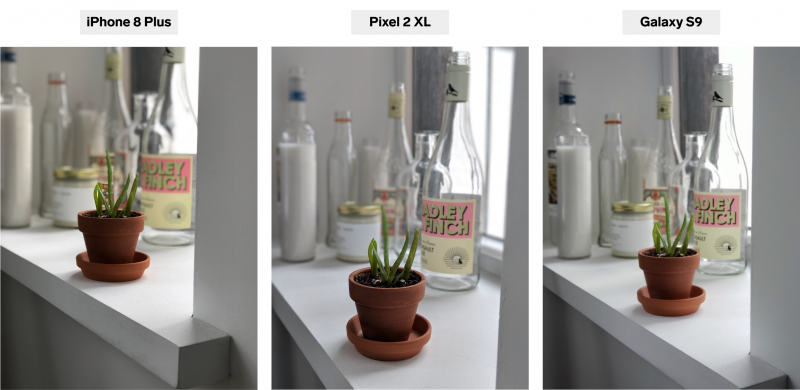
I wanted to test how the phones would handle a busy background - surprisingly, the iPhone 8 Plus and Galaxy S9 won this round.
- Despite an incredibly busy background with various colors and textures, not to mention a challenging subject, the iPhone 8 Plus took a great photo. It managed to keep all the plant's leaves in focus and blur almost the rest of the background - if you look closely, it accidentally kept one of the wine bottle labels in focus.
- The Pixel 2 had a poor showing during this test. While the photo is nice and sharp, the phone accidentally blurred out one of the leaves of the plant. Plus, one of the labels on the wine bottles is a little too in focus, which distracts from the actual subject of the photo.
- The Galaxy S9 did the best job in this case. The overall result isn't quite as sharp as the other two photos, but it did the best job of keeping the subject in focus and blurring the background.
Winner: Galaxy S9
All three phones did an excellent job in bright, natural light indoors.

It's hard to pick a winner in this case, because all three phones took a great photo.
- The iPhone 8 Plus is the brightest and warmest of the bunch. The phone gave my skin a nice glow, and created a nice background blur. If you look closely, it did give my hair a strange shape and missed a few strands of my hair, but I expected that.
- The Pixel 2 also took a beautiful photo, and one that's much sharper than the other two. When it comes to a portrait of a person, however, that's not always the best thing. The Pixel 2 defined my pores a bit too much, and I felt like the overall cooler tone of the camera made my skin look a little lifeless.
- The Galaxy S9 did a fantastic job here. It had fewer issues with strands of my hair than the iPhone 8 Plus did, and the colors look truer to life. Plus, the Galaxy S9 gave my skin a dewy, fresh look, which happens when you take selfies with the phone, too. That being said, the face-smoothing went a little overboard - if you look closely, I look too airbrushed for my taste.
Winner: iPhone 8 Plus
This monochromatic shot was tricky, since there wasn't a lot of separation between the subject and background — but all three phones prevailed.

This shot is a great example of the color and light differences between each camera. The iPhone 8 Plus is significantly warmer than the other two, and the Pixel 2 is decidedly darker than the other phones.
Aesthetic differences aside, all three phones did just fine when it came to little background separation.
- The iPhone 8 Plus did an excellent job keeping the entire subject in focus, even in tricky areas like the camera strap. But the end result is way too bright and too warm for my taste, and the phone blew out both the white wall and white shelf.
- The photo taken with the Pixel 2 could have used a bit more background blur - you can still make out the word "Instax" on the camera on the right. However, that's made up for by the fact that the subject is incredibly sharp.
- The Galaxy S9 did a nice job here, and took a nearly identical photo to the Pixel 2. However, while the background blur is better with the Galaxy s9, the subject isn't as sharp.
Winner: Pixel 2
So, which one is the winner?
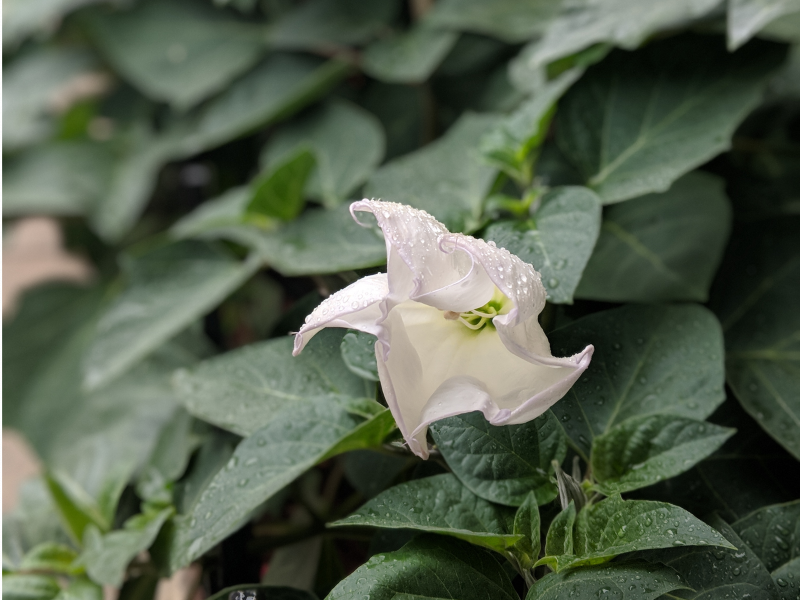
Google's Pixel 2 XL takes the crown here.
All three phones had their own strengths, and their own sets of issues. While the iPhone 8 Plus took gorgeous photos, I found that they often looked too warm. The Galaxy S9 handled colors beautifully, but it failed in light that was too low or two bright.
And both the iPhone 8 Plus and the Galaxy S9 presented a key problem: They forced you, a regular user, to have to think like a photographer. You had to remember to find enough light, to create enough distance between yourself and the subject, and to create enough distance between the subject and the background. It was a time-consuming process, and one that didn't lend itself to snapping a quick photo on a whim, like most typical smartphone users do.
The Pixel 2 not only took sharp, beautiful photos most consistently, but it was significantly easier to use than either of the other two phones. I didn't have to worry about how far away I was or whether there was enough light - the phone took care of those things for me. The Pixel 2 proved that portrait mode can be handled entirely by a single lens and great technology, and that dual-lens smartphone cameras are something of a gimmick.
In general, the Pixel 2 has an excellent camera. But this test proves that even when it comes to a specialized feature like portrait mode, the Pixel 2 is the best there is.

